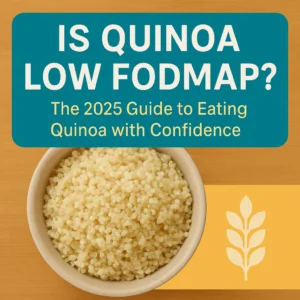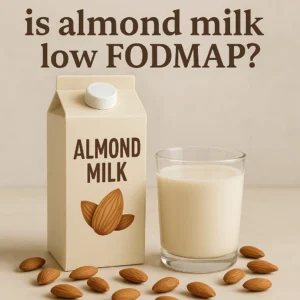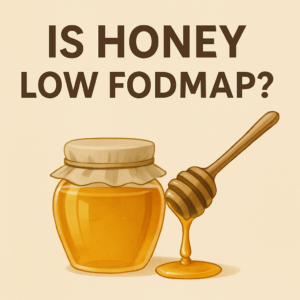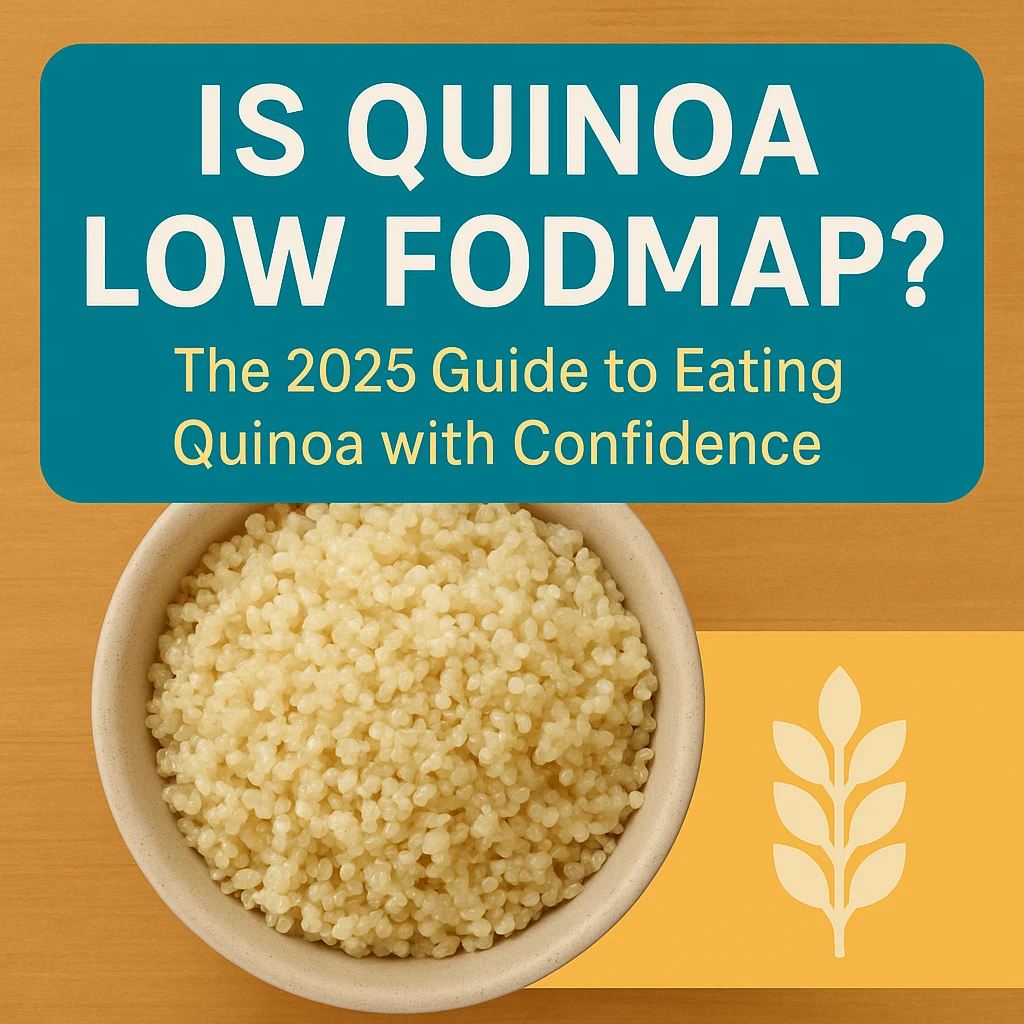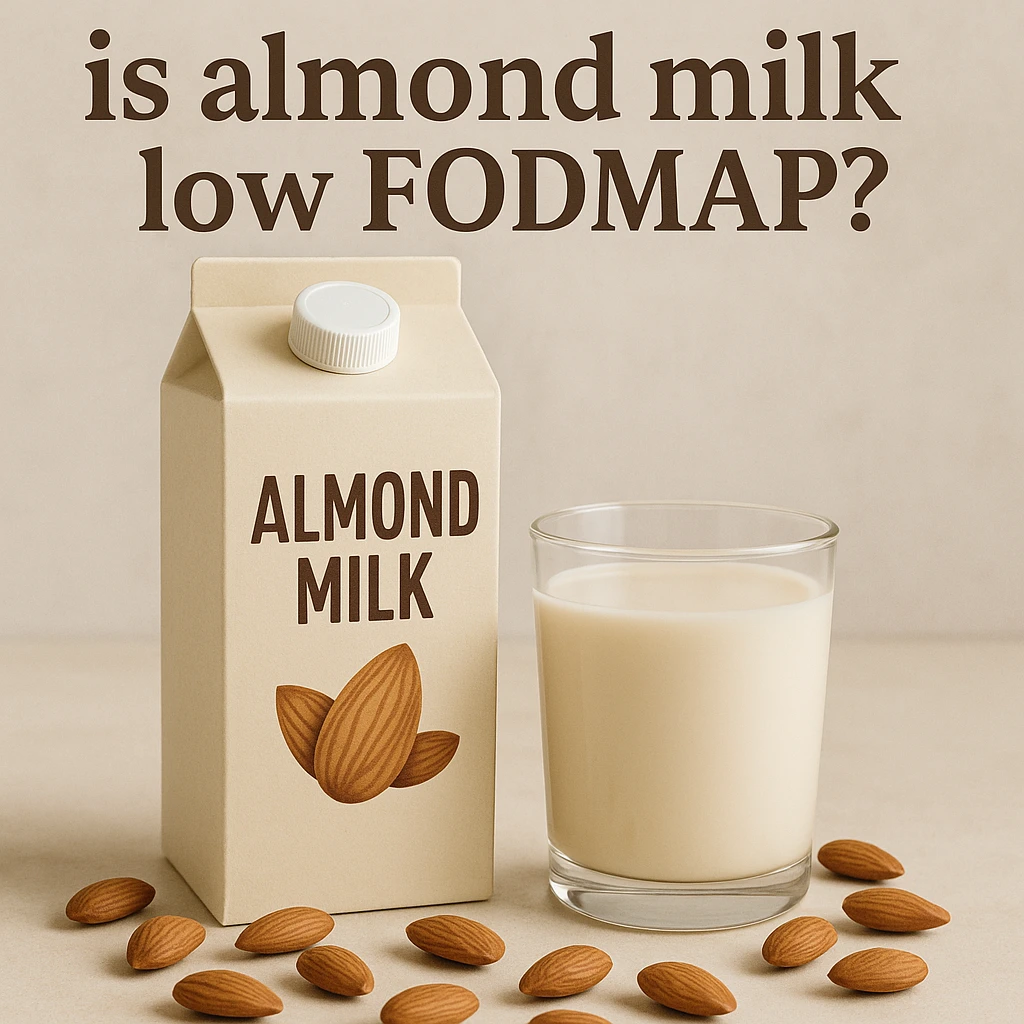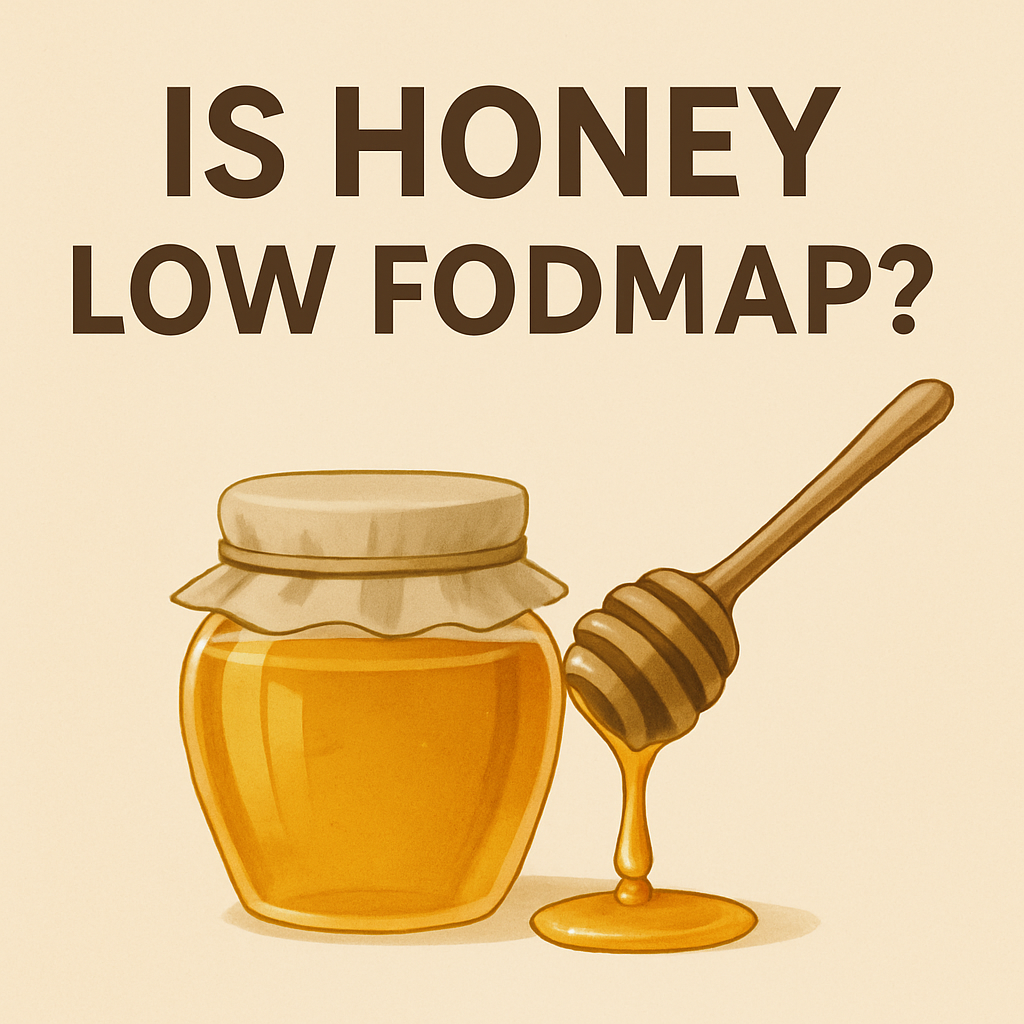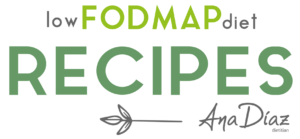If you’ve ever wondered whether bananas are safe to eat on a low FODMAP diet, you’re not alone. This question comes up often, and the answer is yes, but with a few important details.
The key is knowing which type of banana you’re eating and how ripe it is. Let’s walk through this together, gently and clearly, so you can enjoy bananas with confidence.
Table of Contents
What Does “Low FODMAP” Mean?
Understanding FODMAPs
FODMAPs are a group of fermentable carbohydrates that can trigger digestive symptoms like bloating, gas, and discomfort. They’re common in many everyday foods, including bananas.
Managing FODMAP intake, especially if you have IBS, can bring significant symptom relief.
Two Types of Bananas: And Why It Matters
Before we talk about ripeness, it helps to know that there are two main kinds of bananas you might find:
- Common bananas (also called Cavendish): long, curved, and what most people think of when they hear “banana”.
- Sugar bananas (also called Lady Finger bananas): smaller, sweeter, and slightly shorter.
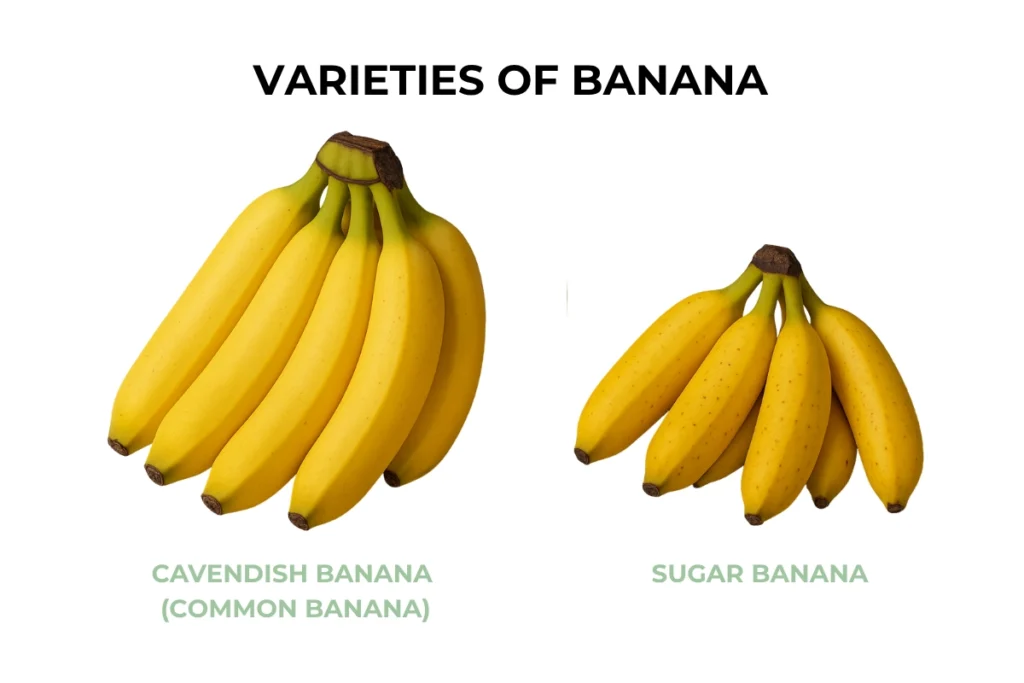
Why is this important?
Because the ripeness of sugar bananas doesn’t affect their FODMAP content much. Whether they’re green, yellow, or very ripe, they tend to stay low FODMAP if you eat a standard serving.
But with common bananas, ripeness really matters. As they ripen, their FODMAP content changes—and that’s where we need to pay closer attention.
Common Bananas and FODMAPs: What Changes With Ripeness?
As common bananas ripen, the starches inside them turn into sugars. And with those sugars come higher levels of a FODMAP called fructans, which can trigger symptoms in people with sensitive digestion.
Here’s a clear guide to help you know which stage is safe, and when you might need to cut back.
The 5 Ripeness Stages of Common Bananas
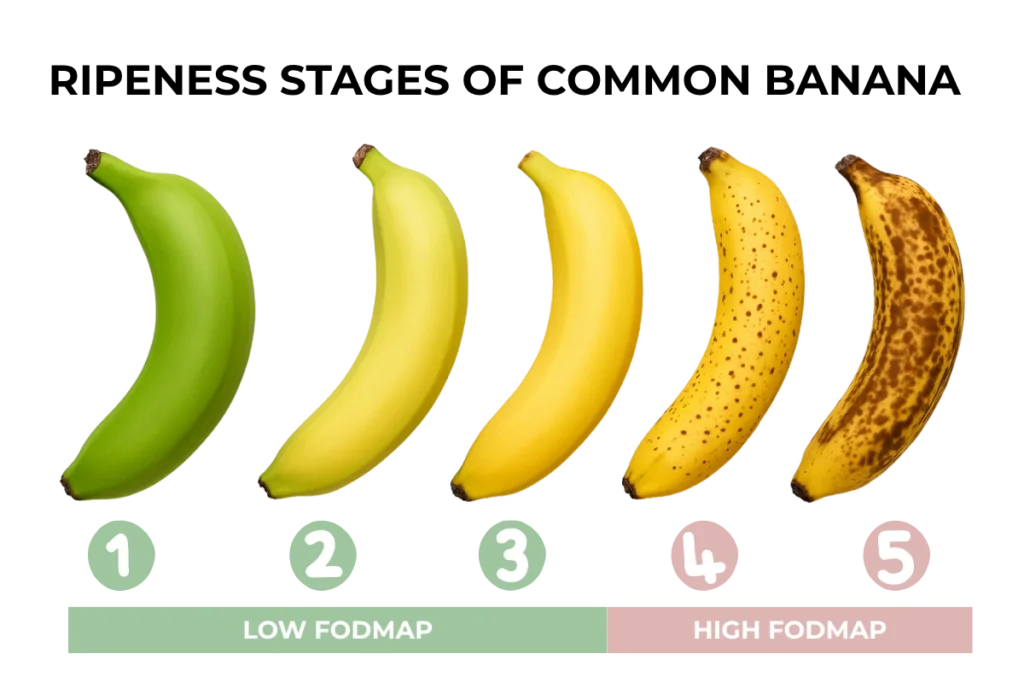
Stage 1: Green banana
- Firm and slightly bitter
- Low FODMAP
- Safe at 1 medium banana (about 95 g)
Stage 2: Pale yellow banana, no spots
- Milder flavour, still firm
- Low FODMAP
- Safe at 1 medium banana (about 95 g)
Stage 3: Firm yellow banana, no spots
- Sweet, easy to digest, still no brown marks
- Low FODMAP
- Safe at 1 medium banana (about 95 g)
Stage 4: Yellow banana with a few freckles
- Riper and sweeter
- High FODMAP
- Stick to a small serving: about 1/3 of a medium banana (around 37 g)
Stage 5: Very spotty banana
- Very ripe, soft, and sweet
- High FODMAP
- Also limited to a low serve: 1/3 of a medium banana (around 37 g)
As you can see, the first three stages are your safest bet if you’re trying to keep your FODMAPs low. Once freckles appear, it’s time to cut back, unless you’ve already tested your tolerance and know your limits.
Sugar Bananas: A Bit More Flexible
With sugar bananas, the rules are simpler.
No matter how ripe they are (green, yellow or very ripe) they remain low FODMAP at a standard serve of about 112 g (around 2 small or 1 medium sugar bananas).
So if you’re in the mood for something a bit sweeter, sugar bananas can be a good option even when ripe.
Just keep portions in mind, as eating large amounts of any fruit, even low FODMAP, can still add up and affect digestion.
A Simple Phrase to Remember
If you ever feel unsure at the fruit bowl, just think:
“No spots, no bloat.”
That’s your gentle reminder that for common bananas, if there are no brown spots, it’s likely safe for most people with IBS to enjoy one whole banana.
Once the spots appear, try a smaller portion, or save that ripe banana for someone else’s smoothie.
In Summary
Here’s a quick recap to help you choose the right banana:
Two banana types:
- Common bananas (Cavendish): You need to watch how ripe they are.
- Sugar bananas (Lady Finger): More forgiving, ripeness doesn’t make much difference.
For common bananas:
- Green to firm yellow with no spots: Low FODMAP, 1 banana is safe.
- Yellow with freckles or spotty: High FODMAP, stick to 1/3 banana.
For sugar bananas:
- All ripeness stages are generally low FODMAP, as long as you stay within the standard serve.
And remember…
“No spots, no bloat.”
Let that phrase guide you gently at snack time.
Frequently Asked Questions (FAQs) About Bananas in a Low FODMAP Diet
Are bananas low FODMAP?
Yes, bananas can be low FODMAP, but it depends on the variety and how ripe they are. Sugar bananas are low FODMAP at a standard serve no matter how ripe they are. Common bananas are only low FODMAP when they’re still green or firm yellow with no brown spots.
Can I eat a whole banana on a low FODMAP diet?
Yes, if it’s a common banana that’s green or yellow with no spots, or a sugar banana in the right portion. Once common bananas become spotty, you should reduce the portion to about 1/3 to stay within low FODMAP limits.
Are overripe bananas high FODMAP?
Yes. Bananas with many brown spots (very ripe) are high in FODMAPs. If you’re still in the elimination phase of the diet, it’s best to avoid them or stick to a very small portion (around 1/3 of a banana).
How many bananas can I eat in a day?
It’s best to stick to two low FODMAP fruit servings per day, spaced out by several hours. That might mean two firm bananas, or one firm banana and another low FODMAP fruit later on.
Can I freeze bananas and still keep them low FODMAP?
Yes, as long as you freeze the bananas while they are still firm and spot-free. This keeps their FODMAP content low and makes them perfect for smoothies or frozen banana snacks.
What’s the difference between sugar bananas and common bananas?
Sugar bananas (Lady Finger bananas) are smaller and sweeter. They’re more stable in terms of FODMAPs and can be enjoyed ripe or unripe in a standard serve. Common bananas (Cavendish) are larger and their FODMAP content changes significantly with ripeness.


